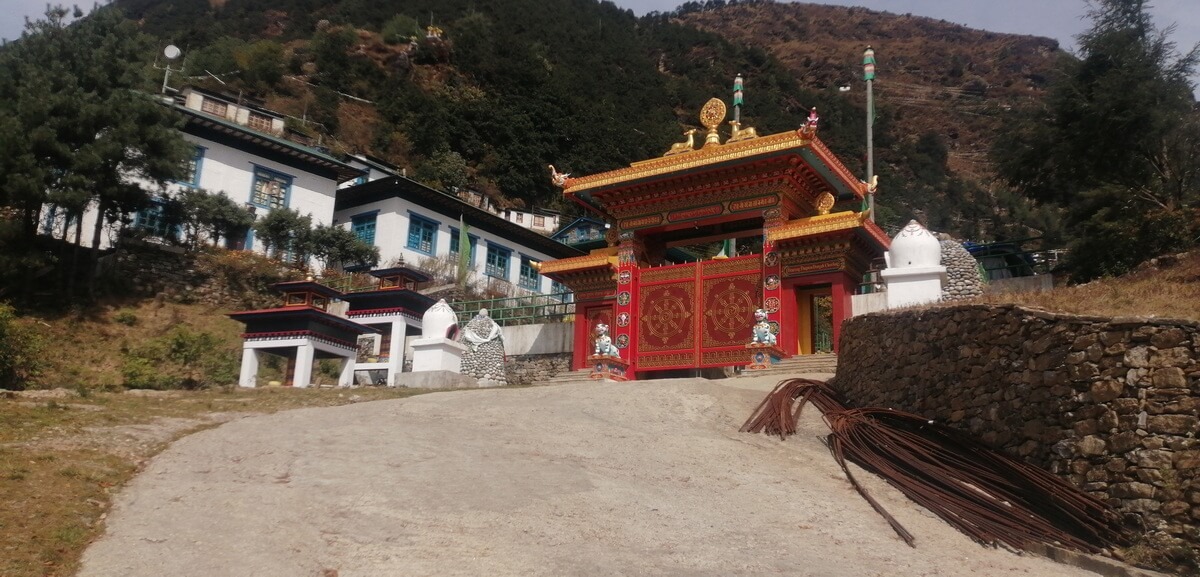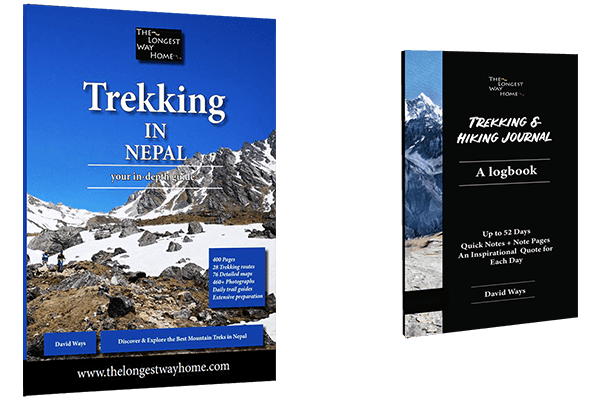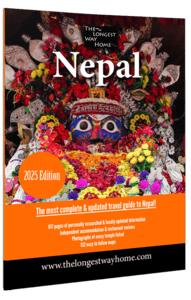

The final trekking day of the Pikey Peak Trek
A true Pikey Peak trek is a nine day trek as you can see from the itineraries. Tomorrow is all about getting from Phalpu to Kathmandu which is rather boring to read about, but restfully bumpy if you are on it. The trek from Junbesi to Phalpu or Salleri follows a dirt trail. It’s easy to follow with not much traffic. Most trekking agents will try to delay it, but I prefer to explore more. So, with that in mind, I would like to introduce a side trek you can take.

For those heading north to Lukla and beyond to the Everest Base Camp Trek or Gokyo this can be a small diversion. For those going to Phalpu this is probably going to set you back a day. But it depends on how fast you trek. You’ll hardly make it to Phalpu by nightfall if you do this side trek, so my advice is to think if this type of side trek is “your thing” or not. If not, it might just be that you would like to spend another night in a village.
For anyone interested in Tibetan Monasteries, we are heading due north of Junbesi to Thubten Choling one of the first and last Tibetan exile monasteries in Nepal
Thubten Choling
Thubten Choling was founded in the 1960s by Trulsik Rinpoche who fled Tibet in 1959. The monastery is an independent and autonomous institution which meant it remained relatively unknown and therefor protected from the rest of the world for many years.
This remote monastery houses some 700 monks. Many of these male and female monks are refugees and have no status in Nepal or anywhere else. Pilgrimages take place every year from India to Thubten Choling. In 2001 the Ringpoche began ensuring the new monastery that we see today was built. Today these monks still have no status in Nepal which is being pressured by China to send them back.

The interesting ecological points of this monastery are that they out number the local residents seven to one. The only fuel for cooking or heat is firewood. The monks re plant thousands of trees every year. As noted on the Pikey Peak trek from Jase Bhanjyang to Junbesi there are scores of young saplings along the trails. It’s mainly the monks who have been replanting these.
Many people contact me looking for monasteries like this to “meditate”, “learn about Buddhism”, in the space of a night or two. Sorry, but that doesn’t happen. There are other institutes set up for that. And, unfortunately many have turned into for profit tourist traps. Thubten Choling is not one of these. It’s a genuine monastery. As you read here such places have real life issues and need far more than a short stay tourist to survive. Tree planting, political acknowledgement, etc. While tourism can help, it’s minimal. Getting a photo with a monk is not exactly helping the cause. Donations are one thing, but so is the ability to offer long-term support for sustainable projects. Sorry, if this seems like a “tourism bummer”. But it’s the reality and I do feel that people visiting the region and monastery should be made fully aware of the situation these monks face.
Onwards to Phalpu on that road
The road to Phaplu from Kathmandu was never meant for tourists. It was set up by the government after Lukla airport was built. It’s sole purpose was not to provide better supplies to the region, but to export goods out of the region! While there were objections from locals who said it would discourage trekkers even more, it was still built as trekkers had already dwindled due to the airport at Lukla.

The interesting twist in this tale comes from the road section from Salleri to Junbesi that we trek today. This road was funded by locals and Thubten Choling. Upon seeing the Kathmandu Salleri road being built, they decided to add on to it as their fates were already sealed. The idea of this part of the road was to encourage pilgrims to the monastery and indeed open up trade with Junbesi which was famous in its own right as nice village to visit.
And so we reach Phalpu. Whether you took the extra day to visit Thubten Choling or you trekked directly on from Junbesi on the Pikey Peak trek. Tomorrow all that remains is a flight or jeep back to Kathmandu. I’ll finish off this trek with a recap and honest appraisal of the Pikey Peak trek.
Pikey Peak 9-day trek
- Day One Trekking Pikey Peak: – Permits, Planning & Kathmandu to Shivalaya
- Day Two Trekking Pikey Peak: – Shivalaya to Bhandar
- Day Three Trekking Pikey Peak: – Bhandar to Namkheli
- Day Four Trekking Pikey Peak: – Namkheli to Nagaor Gumba
- Day Five Trekking Pikey Peak: – Nagaor Gumba to Pikey Peak Base Camp
- Day Six Trekking Pikey Peak: – Pikey Peak Summit to Jase Bhanjyang
- Day Seven Trekking Pikey Peak: – Jase Bhanjyang to Junbesi
- Day Eight Trekking Pikey Peak: – Junbesi to Phalpu
- Day Nine Trekking Pikey Peak: – return to Kathmandu
Unlock the ultimate trekking adventure with my Guidebooks to Nepal!
Elevate your trekking experience with the most comprehensive guidebook dedicated to Trekking in Nepal. Discover 29 full treks (including this one) spanning over 400 pages, providing unparalleled insights. What sets it apart? It’s the only guidebook globally featuring trekking links, guiding you on seamlessly connecting treks Whether you prefer an instant download or the paperback edition shipped worldwide, this guidebook is your passport to unmatched exploration.
Ready to embark on a journey beyond the ordinary?

Get the Digital Trekking in Nepal guidebook!
Grab the Paperback Trekking in Nepal Guidebook!
Explore the Paperback Trekking & Hiking Journal!
If you’re seeking a holistic guide covering the entire country or focusing on the most popular treks, dive into my full Nepal Guidebook. It stands as the world’s sole guidebook incorporating entry prices for every attraction, comprehensive maps, and, of course, the finest information.
Discover why this book surpasses all others: Find out more here!


It’s inspiring to see the efforts at Thubten Choling Monastery. How can visitors support the monastery sustainably?
That’s a tough one to answer. I think bringing up the topic of long-term refugees not being recognised at Thubten Choling Monastery is something that can help in the long-term. I know people like to donate, but it ends up with a culture of donations vs sustainability. I would rather support the monastery at least to have the monks recognised as citizens, following that look at what they want in regards to the future of the monastery.
David, the side trek to Thubten Choling sounds fascinating. How do you recommend balancing this detour with the overall trek schedule?
If you are into monasteries, and exploring an area thoroughly then yes, by all means it’s worth the day. If not, it’s not really an average tourist sight looking for big mountains etc.
Is there a best time of year to visit this monastery?
The typical spring and autumn peak seasons for visiting Nepal is best.
The road from Kathmandu to Phaplu sounds like it’s impacted the trek. Do you think it detracts from the trekking experience?
Not from the route we took. Yet. But there are plans to extend the road all the way to Lukla. That will affect anyone coming just for trekking and avoiding roads. In this case it’s best to look a Pikey Peak as its own trek in the future rather than a part of the Everest Base Camp historic trek. Similarly that Dhap route, if it becomes promoted by tour operators with jeeps etc, then Pikey Peak won’t be long becoming a commercial area like Poon Hill. Given Nepal’s development over the past few years, this is likely the route it will go. But it’s a quite a few years away and there’s still time to enjoy the real natural trekking experience that Pikey Peak currently offers from the route we took here.